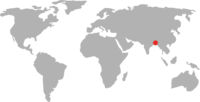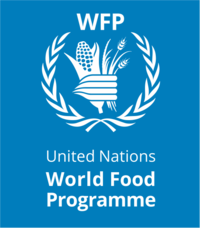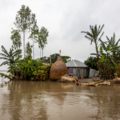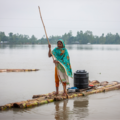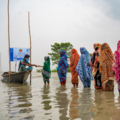ANTICIPATORY CASH TRANSFERS IN CLIMATE DISASTER RESPONSE
OUR AIMS
Humanitarian workers carry out incredible lifesaving work every day on the front line of crisis response to assist those in the greatest need. Yet repeatedly, despite the fact that although billions of dollars are spent annually on humanitarian support to households in crisis, we have extraordinarily limited evidence on the impact of this support. This project is the first large-scale evaluation that rigorously tests the impact of humanitarian cash transfers in response to a sudden climate shock, and the importance of being timely for an impactful response.
This project seeks to address the knowledge gap by examining the welfare impact of a one-off anticipatory cash transfer provided to households forecasted to experience extreme floods in Bangladesh.
ABOUT THE PROJECT
In 2020, Bangladesh experienced the second highest recorded floods since 1989. More than one million households were inundated, and 5.5 million people were directly affected by flooding at the beginning of August 2020. Flood waters halted agricultural production, disrupted food markets, schools, and health services, and damaged infrastructure.
By carrying out the fastest cash allocation in their history, the Central Emergency Response Fund (CERF) enabled the World Food Programme (WFP) to deliver cash to about 23,000 households a week before the local flood peak. This anticipatory action was part of a vital series of anticipatory action pilots supported by the UN Office for the Coordination of Humanitarian Affairs (OCHA). With support from the International Federation of Red Cross and Red Crescent Societies (IFRC) and the Bangladesh Red Crescent Society (BDRCS), the government and local NGOs, the United Nations was able to provide support to more than 220,000 people a few days prior to and during peak flooding.
Unlike previous years when response preparation started after devastating flooding materialised, WFP provided a small cash transfer of $53 via mobile money to over 23,000 households in advance of peak flooding, based on flood predictions and an action plan that had been approved at the start of the monsoon season. The response in 2020 was faster, and cheaper than during the last major floods in 2017 and 2019, when support arrived about 100 days after peak flooding.
Evidence on the impact of a one-off cash transfer in a disaster are limited, despite the widespread use of such transfers in crises, reflecting more broadly a dearth of evaluations in the humanitarian sector. To assess impact, we exploit administrative constraints experienced during the programme roll-out caused by the quick onset of the flood and restrictions on movement as a result of Covid-19, to compare households who received a cash transfer, with otherwise comparable households which did not receive the cash transfer.
10 to 12 weeks after the cash transfer, researchers randomly sampled and surveyed a large number of households over the phone, with almost 9,000 households forming the sample of interest. The survey data was complemented by satellite imagery to measure the flood intensity and timing at mauza level, the smallest administrative unit in Bangladesh.
RESULTS
The study found that the cash transfers increased the choice set of actions available to households. Households changed their behaviour in ways that altered the trajectory of the flood impacts and could have long-term benefits. Cash-receiving households were able to evacuate household members and livestock and stock up on food, with an immediate and large impact on food security during the floods. Households that received the cash transfer were 52% less likely to go a day without eating if they had received the transfer, compared to households that did not.
The anticipatory cash transfer did more than provide temporary relief during the flood. Its effects were still present three months later, impacting both current and future welfare. Children in households that were sent the cash transfers were 3.8% more likely to have consumed three meals in the day prior to the survey. Stated wellbeing was 18.7% higher. The anticipatory cash transfer also mitigated asset loss and boosted earning potential -- an early sign of recovery.
The effect sizes after three months are modest, but surprisingly broad for a one-off cash transfer amounting to two weeks of food expenditure but delivered during floods that lasted much longer.
Our results suggest three important takeaways for crisis response. First, early action in a crisis matters. Failing to act early has real welfare costs. The welfare impacts measured in this paper occurred before humanitarian assistance would have typically arrived, although we do not negate the value of post-shock support for recovery. Our results also show that anticipatory cash transfers can alleviate losses that are known to have scarring effects, such as on child food consumption. Second, even when acting early, speed of delivery matters. Households that were sent the cash transfer one day earlier relative to the local flood peak experienced a small improvement in adult food consumption three months later. This highlights the importance of upfront investments in preparing and targeting well in advance of the predicted extreme weather event, such that the intervention can scale immediately with the activation of triggers. Third, this unusually large-scale evaluation of a humanitarian intervention presents lessons for measuring the impact of other humanitarian programmes, in a context where there are real challenges to conducting rigorous evaluations and the evidence base is thus slim. Much more learning on crisis response is needed.
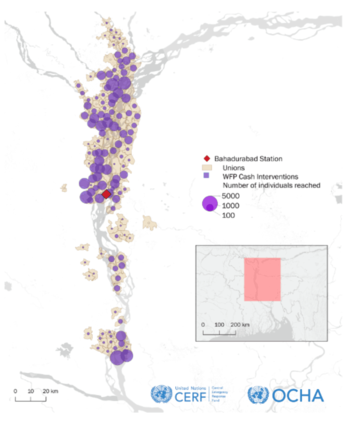
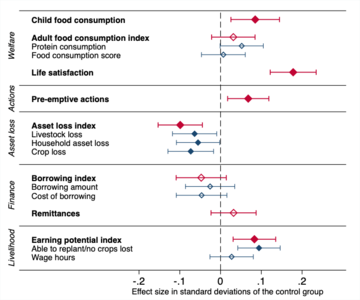
Image description: (Left) Map of the distribution of WFP cash to households along the Jamuna River in northern Bangladesh. The size of the purple dots indicate the number of households targeted in each union. Bahadurabad Station was used to forecast the water levels and activate the triggers. (Right) This image summarises the welfare effect of the cash transfer relative to the control group. Markers indicate the standardised mean treatment effect of receiving the cash transfer on pre-specified outcomes (red) and the sub-indices used in constructing the main outcomes (blue), with 95% confidence intervals shown. Solid markers indicate significance at the 5% level, whereas the transparent markers indicate that we cannot reject the null hypothesis that these effects are significantly different from zero. Covariates include age, gender, education level, household size, dependency ratio, house structure, UNFPA/FAO recipient status and land type. Union fixed effects are included.


